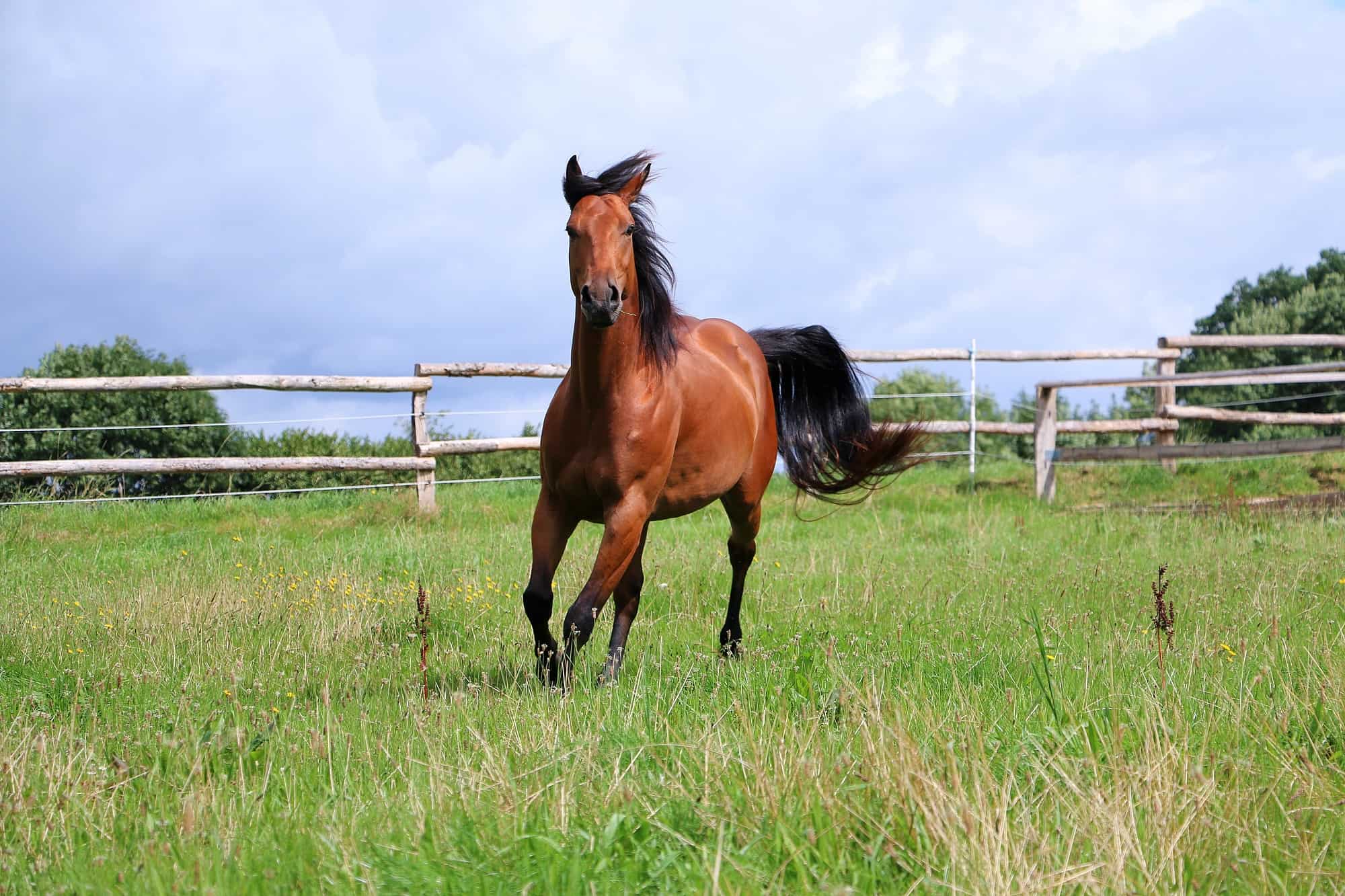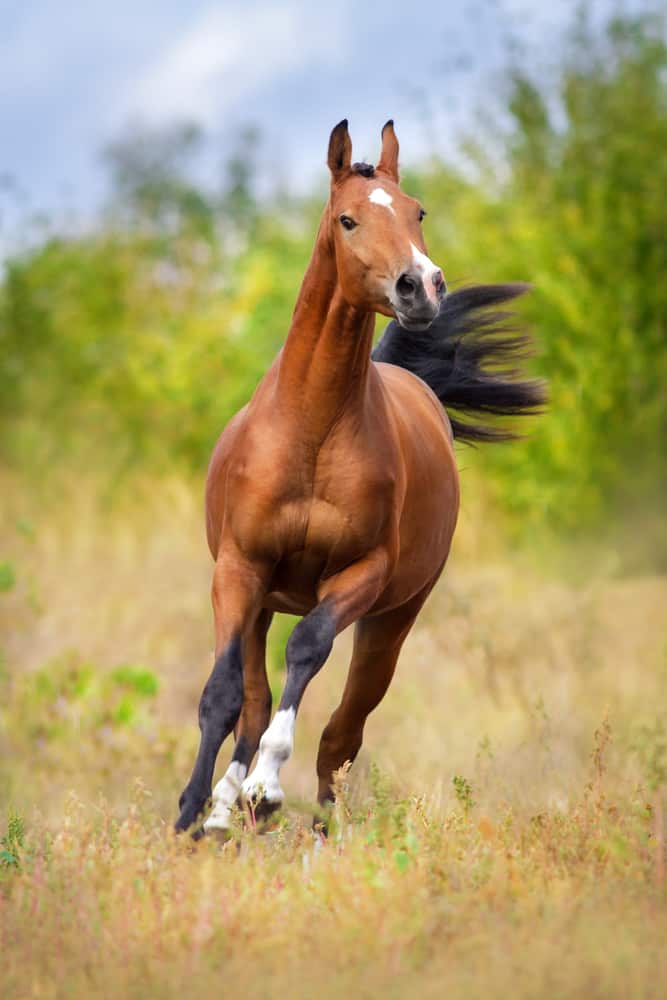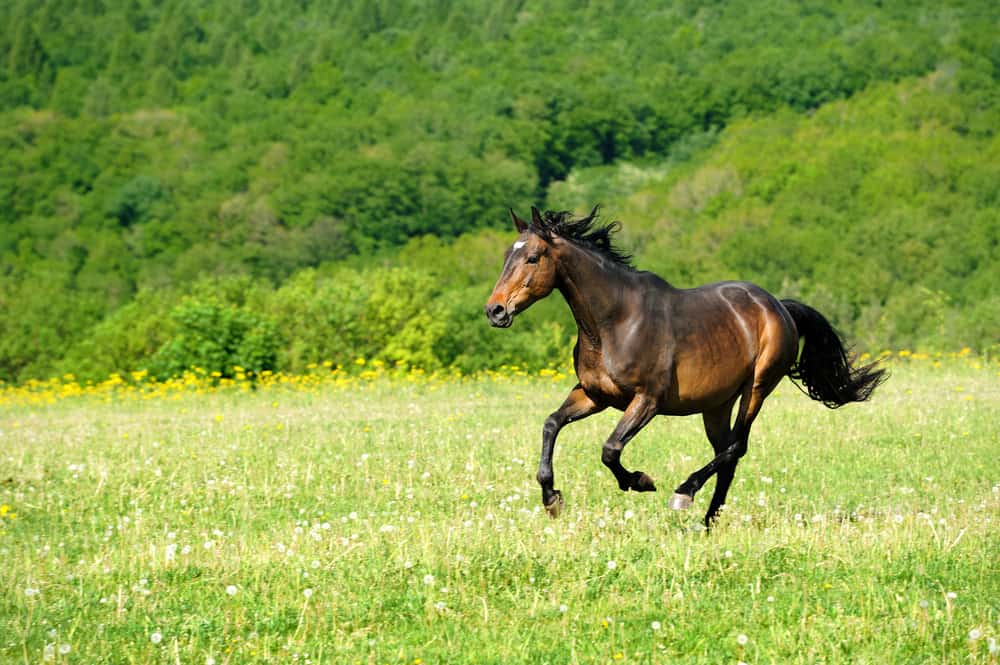If you are a horse lover or plan to buy one, you probably wonder how fast a horse can run and what factors affect its speed. The average horse speed is approximately 30 mph (48 km/h), but some famous racehorses run incredibly fast and achieved higher speeds.
However, it is only a matter of statistics since it can be hard to compare two entirely different horse types. Some of them are the fastest, but only on the short distance. Others are maybe slower but more durable, so they can surprise you when it turns out they are faster in the long run.
Horse Speed
There are four ways how the horse moves, including walk, trot, canter, and gallop.
- Walk – The horse picks up one foot at a time and follows a four-beat rhythm while walking. It is a natural horse step when it moves at a speed of 2 meters per second.
- Trot – This gait type reminds of jog and follows a two-beat rhythm. The average horse can cross 10 meters per second in this rhythm.
Horse speed |
|
| Gait | Average speed |
| Walk | 4.3 mph (6.9 km/h) |
| Trot | 8 mph (12.9 km/h) |
| Canter | 10 to 17 mph (16 – 27.3 km/h) |
| Gallop | 25 to 30 mph (40.2 – 48.3 km/h) |
- Canter (lope) – It is a steady, three-beat gait faster than a trot and slower than a gallop.
- Gallop – It is the fastest, four-beat horse movement variation.
How Fast Can a Horse Run?
The average racehorses speed is approximately 40 to 44 mph (64 to 70 km/h). The rigidly trained animals can reach it for less than 20 seconds. However, most of them can’t run faster than 20 to 30 mph (32 – 48.5 km/h) on average with a rider on their back.
The fastest recorded galloping speed is 55 mph (88.5 km/h). American Quarter Horses can reach it while sprinting a distance shorter than 400 m.
The top speed recorded over 400 m is always lower. Winning Brew, a two-year-old Thoroughbred, run 43.97 mph (70.76 km/h) at the Penn National Race Course in 2008.
Even though it wasn’t the fastest horse in history, Eclipse was the most successful Thoroughbred ever. It was an undefeated racehorse that lives in England in the 18th century. That horse won fantastic eighteen races, including eleven King’s Plates.
Famous horse breeds top speed |
|
| Breed | Average running speed |
| American Quarter | 45 to 55 mph (72.5 – 88.5 km/h) |
| Andalusians | 45 to 50 mph (72.5 – 80.5 km/h) |
| Orlov Trotter | 45 mph (72.5 km/h) |
| Paint Horse | 40 mph (64.5 km/h) |
| Mustang | 35 to 50 mph (56.5 – 80.5 km/h) |
| Akhal-Teke | 35 to 45 mph (56.5 – 72.5 km/h) |
| Thoroughbred | 35 to 44 mph (56.5 – 71 km/h) |
| Arabian | 34 to 40 mph (55 – 64.5 km/h) |
| Appaloosa | 30 to 40 mph (48.5 – 64.5 km/h) |
| Wild Horse | 30 to 40 mph (48.5 – 64.5 km/h) |
| Standardbred | 30 to 35 mph (48.5 – 56.5 km/h) |
| Shire Horse | 30 to 35 mph (48.5 – 56.5 km/h) |
| Friesian Horse | 25 to 30 mph (40 – 48.5 km/h) |
| Belgian Horse | 25 mph (40 km/h) |
| Gypsy Horse | 22 mph (35.5 km/h) |
| Clydesdale Horse | 20 mph (32 km/h) |
| Morgan Horse | 20 mph (32 km/h) |
| American miniature horse | 18 to 20 mph (29 – 32 km/h) |
| Selle Francais | 15 mph (24 km/h) |
| Black Forest | 14 mph (22.5 km/h) |
| Tennessee Walking Horse | 10 to 20 mph (16 – 32 km/h) |
Factors that Determine the Horse Speed
Surprisingly, the horses’ legs length and overall height are not crucial factors that affect their speed. On the contrary, horses with long legs often have a problem with bringing them forward quickly, making these animals slower than those with shorter legs.
For instance, the Thoroughbred is taller than Quarter horse but is still slightly slower. In this case, the crucial feature is the horses’ stride length and its stride rate.
Factors that affect the speed are their breed, health, age, airflow through their respiratory system, individual characteristics, and the weight the horses carry during the race.
Some horses are naturally more athletic and healthier, while others are born to run fast. Training, motivation, and fitness are also vital. No matter how physically capable a horse is, it won’t run fast if it is uninterested in that kind of activity.
On the other hand, a horse that enjoys running will almost always achieve better results than expected. However, a few factors are essential when it comes to speed. Let’s take a look.
1. Genetics
Horse breeds show different genetic possibilities for running, training, and jumping. It depends on both inherited genes and living conditions. In nature, running is a horse’s priority, its defense mechanism, and a condition for survival.
Basically, it is a foundation of natural selection, so only the fastest animals can survive. That is why racehorse breeders are so strict about genetics. They take care to choose only the best, healthiest, and quicker horses to get superior offspring.
That is pretty similar to a natural selection but implemented in unnatural conditions. As a result, you can recognize more than 300 different horse breeds worldwide.
2. Anatomy
As you can guess, horses run fast thanks to proportionate and highly functional muscles and sturdy skeletons. They have both slow-twitch and fast-twitch muscle fibers like any other animal.
However, the distinct muscle fiber composition is different in various breeds, making them suited for particular activities. For instance, horses with more slow-twitch fibers are better in long-distance competitions. They are slower but endurance at lower speeds.
On the other hand, sprinters have more fast-twitch muscle fibers. Therefore, they are better in short races when it is crucial to develop the top speed.
Additionally, horses have large and highly active hearts. Believe it or not, up to 75 gallons (284 l) of blood circulate through the racehorse’s heart every single minute. That way, its body continuously gets needed oxygen during strenuous exercise and can accelerate when needed without negative consequences.
3. Gender
Sex won’t affect the horse’s speed. The difference in speed between colts and fillies or female and male horses younger than four years is only 1%. However, you should know that male castrates are more obedient and calmer than uncastrated ones.
4. Stride
Stride is the distance that a horse gets across in one leap. In other words, it is the distance between the spot where the horse’s hoof hits the ground and the next one where the same hoof touches the land, regardless of the pace.
The average racehorse’s stride length is 20 feet (6 m), but it was recorded that the champion Man O’ War had a stride length of impressive 28 feet (8.5 m).
5. Stride rate
It is the number of strides that racehorses accomplish in a given time. This rate is typically 130 to 140 strides per minute, but the real champions’ stride rates can be more than 160 strides per minute.
6. Stride angle
The stride angle is a gap between a front and back horse’s foot measured at the rear foot push-off point. It is crucial for calculating how far the animal can flatten out during the race. The rule of thumb is that horses with higher and superior stride angles are faster and have longer strides.
7. Jockey
Jockeys’ posture can significantly increase or reduce the burden on the horse’s back and directly affect its top speed. Therefore jockeys often sit in the crouched posture to minimize unnecessary movements and disturb horses’ run. Another crucial thing is the jockey’s weight since heavier jockeys decrease the horse’s top speed.
8. Track surface
An inadequately maintained track can effectively neutralize strenuous training and stride optimization. For instance, horses can sink a bit on the wet tracks, so the animal needs more energy and time to complete each stride. That significantly limits the horse’s maximal speed.
Ways to Make the Horse Run Faster
Even though you can think that a horse’s top speed depends only on factors beyond your control, it is not entirely true. In fact, you can do a few things to improve your horse’s performance.
Regular training
Never skip training since your horse needs to run regularly. Only that way can it fulfill its potential and become fast. Remember that you shouldn’t push your animal to its limit every day since it can cause injuries.
The crucial thing is to determine the ideal training type for your horse and its intensity. Persistent conditioning will lead to increasing the horse’s speed.
Breathing
Always check whether the horse’s airways are unobstructed before training. Any breathing problem will negatively affect its performance.
Quality food and care
You can expect top results only if you feed your horse with high-quality food. Its diet should be rich in necessary proteins, fats, and carbs, but it is also vital to offer supplements to improve its fitness and health.
Summary
High speed is the horses’ top defense mechanism in nature. Breeders have bred racehorses for speed for centuries by imitating natural selection. The goal is to get the fastest animals by forcing genes that control this particular trait.
However, it is not enough. The crucial thing is that horses are well-trained and motivated. Otherwise, they won’t be able to run as fast as their build and fitness allow.











~ Good Evening. My husband and I love horses and have ridden our favorite Quarter horses for the last 5 years or so. My question: since animals are either male or female, why do you refer to horses as “it”? They’re not inanimate objects like a table or chair (it), they’re living, breathing animals, beautiful in form and appearance.
Why does it matter, they are not focusing on one gender or a certain horse, and “it” tells the point of the article just fine, we know what their talking about that don’t we. And it makes sense because the author of this article changes it up so it’s not always “it” it was sometimes “the horse” or “they”, if you keep on calling something by one thing the repetitiveness will make the article sound boring! But as a horse lover they aren’t objects, but you know what humans aren’t objects either and some people go by “it” and that’s fine it’s just the way things are nowadays!